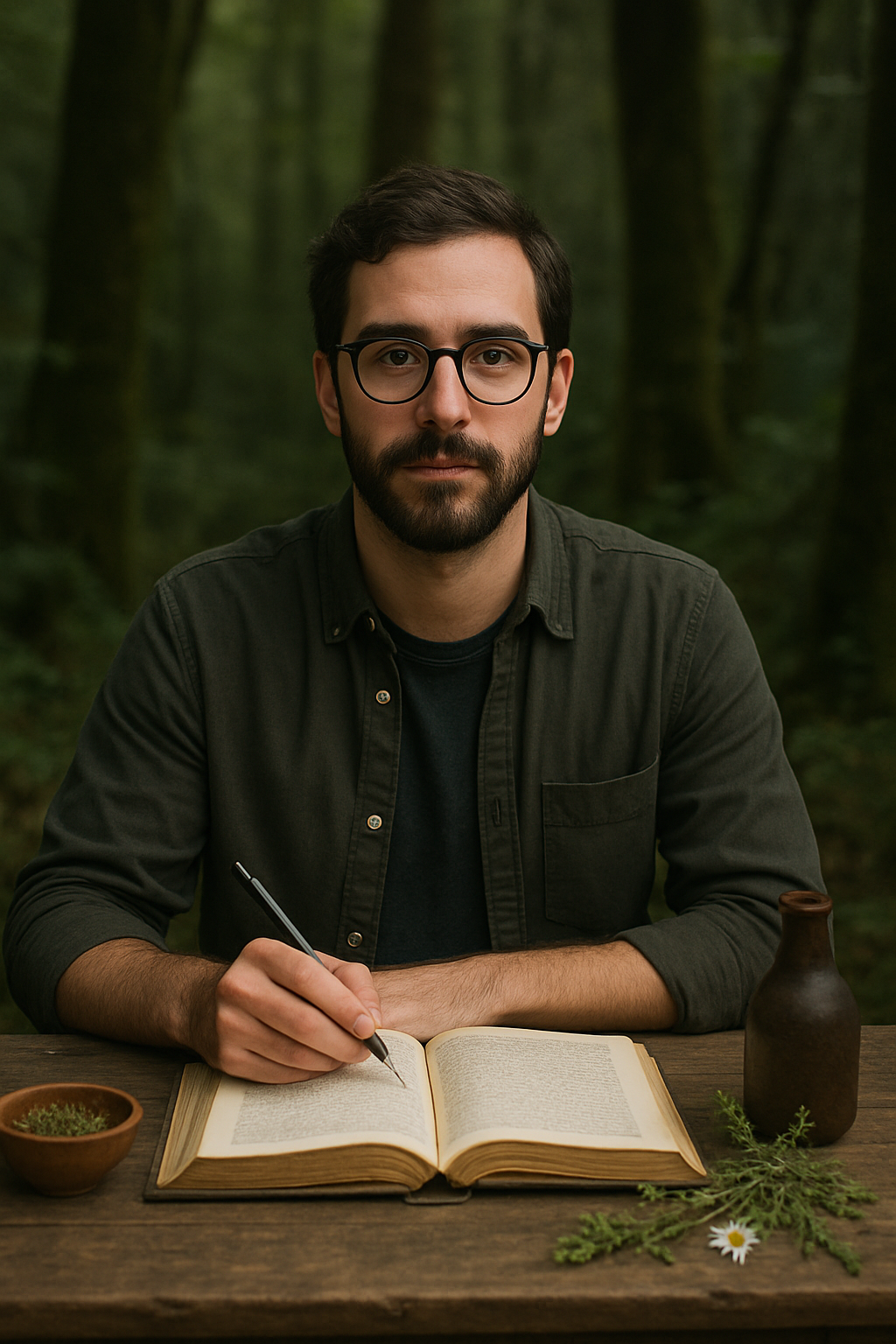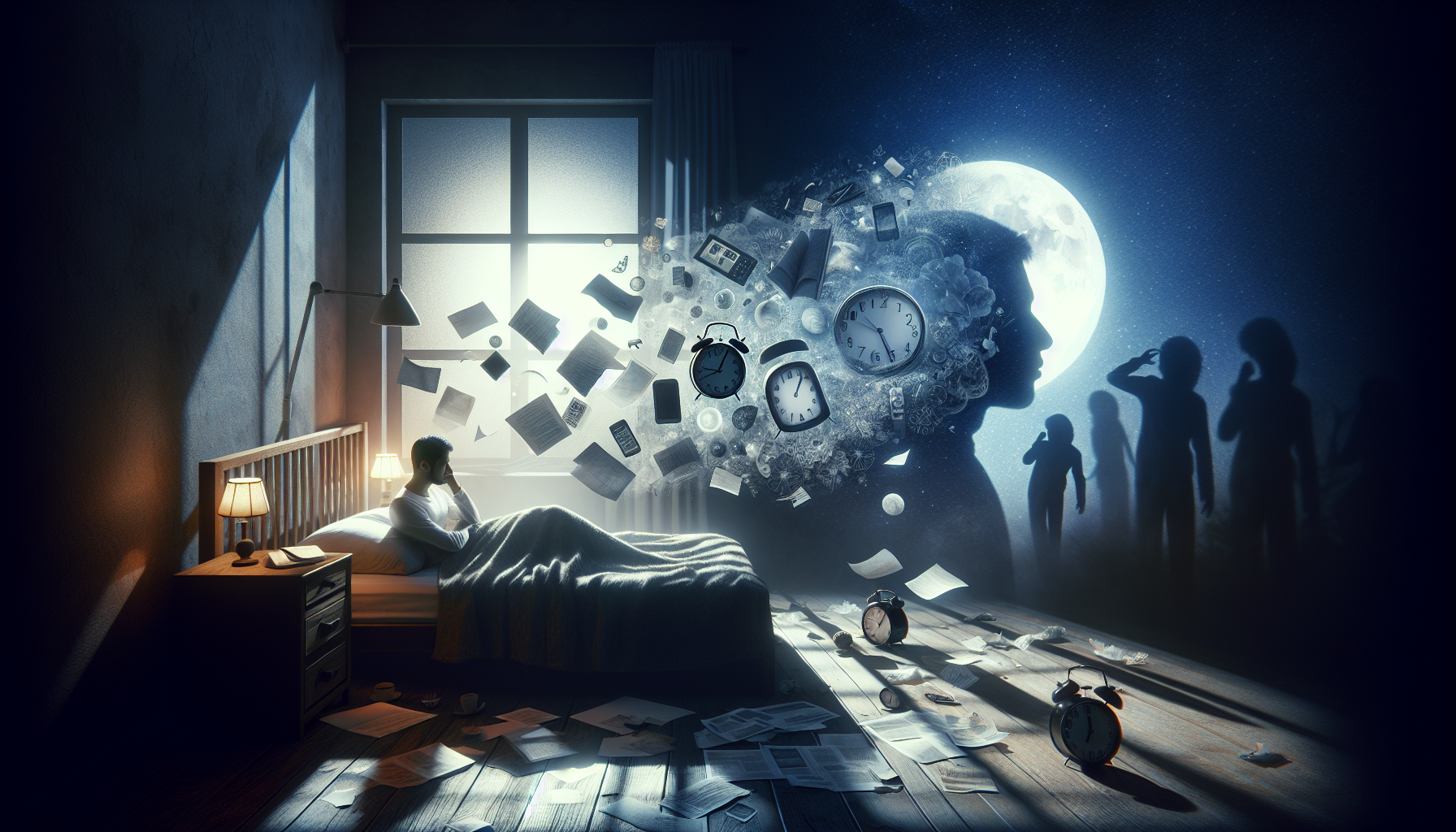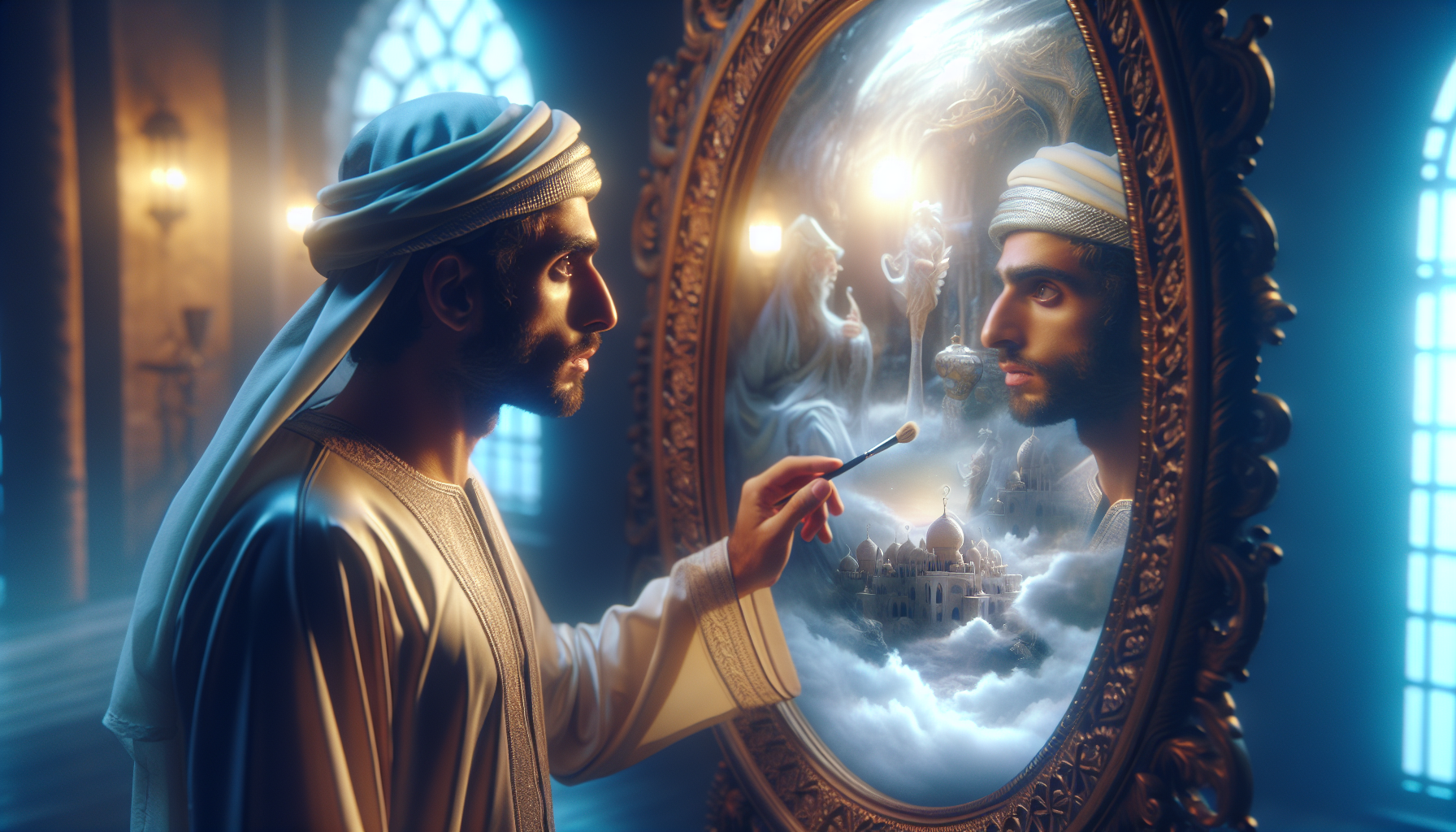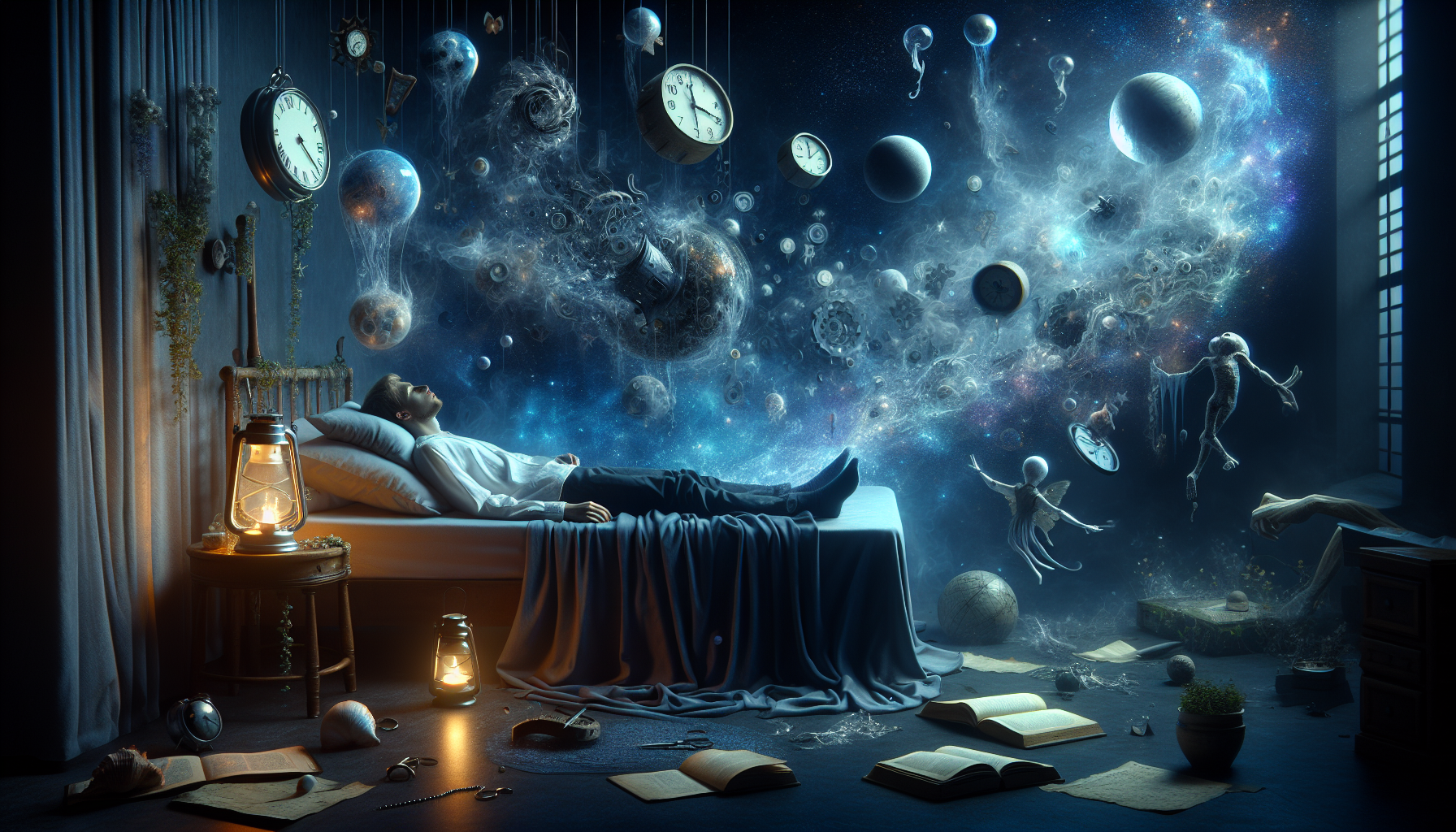In the realm of art, few names resonate as profoundly as Salvador Dalí. His legacy, marked by a distinctive blend of the bizarre and the beautiful, continues to captivate audiences worldwide. Dalí’s ability to transform the intangible realms of dreams into tangible masterpieces sets him apart as a pioneer of surrealism, a movement that defies conventional boundaries and challenges the very fabric of reality. But what fueled Dalí’s vivid imagination? What lay at the core of his unparalleled creative process? In this exploration, we embark on a journey to unlock the surreal, delving into the dream-infused artistry that defined Salvador Dalí. 🌌
At the heart of Dalí’s work lies a profound fascination with the subconscious mind. He drew inspiration from his dreams, weaving a tapestry of intricate symbolism and enigmatic imagery that invited viewers to question their perceptions. The Surrealist movement, with its emphasis on tapping into the unconscious, provided the perfect backdrop for Dalí’s artistic endeavors. It was through his exploration of this uncharted territory that Dalí unearthed a rich reservoir of creativity, enabling him to challenge traditional artistic conventions and redefine the boundaries of expression. His paintings, often described as dreamlike, offer a glimpse into a world where reality and fantasy converge in mesmerizing harmony.
As we delve deeper into Dalí’s creative process, we encounter the curious methods he employed to access his subconscious mind. The “paranoiac-critical method,” a term coined by Dalí himself, became a cornerstone of his artistic practice. This technique involved inducing a state of self-induced paranoia, allowing him to perceive hidden connections between seemingly unrelated objects and ideas. By embracing irrationality and embracing the unexpected, Dalí opened the floodgates to a realm of infinite possibilities, where his imagination could roam freely. This approach not only defined his art but also positioned him as a visionary who dared to venture beyond the ordinary.
Beyond the canvas, Dalí’s influence extended to various forms of media, including film, photography, and sculpture. His collaboration with filmmaker Luis Buñuel on projects such as “Un Chien Andalou” and “L’Age d’Or” showcased his willingness to experiment with different mediums, further blurring the lines between reality and imagination. Dalí’s impact on popular culture was profound, with his iconic imagery infiltrating everything from fashion to advertising. His ability to transcend the confines of traditional art ensured that his work would endure, continuing to inspire and provoke thought long after his passing.
In this article, we will unravel the intricacies of Dalí’s dream-infused creative process, exploring the techniques and philosophies that underpinned his work. From the influence of Sigmund Freud’s psychoanalytic theories to the role of imagination and memory, each aspect contributed to the enigmatic allure of Dalí’s art. We will also examine the lasting impact of his legacy, considering how his daring exploration of the subconscious has influenced contemporary artists and shaped the landscape of modern art. Join us on this captivating journey as we unlock the surreal and uncover the secrets behind Salvador Dalí’s extraordinary creativity. 🎨
The Enigmatic Mind of Salvador Dalí
Salvador Dalí, a name synonymous with surrealism, was a master at blending reality with the dream world. His creative process was a complex amalgamation of various influences, spanning from the depths of his subconscious to the avant-garde movements of his time. Dalí’s ability to unlock the surreal in everyday life is what made him an iconic figure in the art world. His dream-infused creations invite us to explore the boundaries of reality and imagination, challenging our perception of the world.
Born in Figueres, Spain, in 1904, Dalí was exposed to art from an early age. His unique perspective and eccentric personality quickly set him apart from his peers. As a child, Dalí was already experimenting with different forms of art, showing a keen interest in the works of the Impressionists and Cubists. This early exposure to diverse artistic styles allowed him to develop a distinct style that defied categorization. His surrealist approach was heavily influenced by his fascination with dreams, a theme that permeated much of his work throughout his career.
Dalí’s creative process was deeply rooted in the exploration of his subconscious mind. He employed a technique he called the “paranoiac-critical method,” which involved inducing a state of paranoia to unlock his imagination. This method allowed him to access the bizarre and the irrational, elements that became central to his art. Dalí’s work often featured distorted figures, dreamlike landscapes, and intricate symbolism, all of which were reflections of his complex psyche. His ability to seamlessly blend the real with the surreal challenged conventional art forms and left a lasting impact on the art world.
Dreams and the Paranoiac-Critical Method
The relationship between dreams and creativity is a fascinating one, and for Dalí, this connection was at the heart of his artistic process. He believed that dreams were a gateway to the subconscious, a realm where the bizarre and the irrational could coexist with the mundane. This belief led him to develop the paranoiac-critical method, a technique designed to harness the power of dreams and translate them into his art.
The paranoiac-critical method was Dalí’s attempt to simulate the hallucinatory state of a paranoid person. By inducing paranoia, Dalí believed he could unlock the subconscious and access a realm of endless possibilities. This process involved a deliberate suspension of rational thought, allowing the mind to wander freely and explore its hidden depths. The result was a body of work that defied logic and challenged traditional notions of reality.
Dalí’s use of the paranoiac-critical method was not limited to his paintings; it also extended to other forms of artistic expression, including film, sculpture, and photography. His collaborations with filmmaker Luis Buñuel and photographer Man Ray are testaments to the versatility of his method. These partnerships produced some of the most iconic surrealist works of the 20th century, showcasing Dalí’s ability to transcend the boundaries of traditional art forms.
Symbolism in Dalí’s Art
Dalí’s artwork is rich with symbolism, each piece a tapestry woven with intricate details and hidden meanings. His use of symbolism was a reflection of his interest in psychoanalysis, particularly the theories of Sigmund Freud. Dalí was fascinated by Freud’s exploration of the unconscious mind, and this fascination is evident in the recurring motifs found throughout his work.
One of the most notable symbols in Dalí’s art is the melting clock, famously depicted in “The Persistence of Memory.” The melting clocks are often interpreted as a representation of the fluidity of time, a concept that challenges the rigid structure of reality. This motif is a testament to Dalí’s ability to manipulate time and space within his art, creating a dreamlike quality that captivates viewers.
Another recurring symbol in Dalí’s work is the elephant, often depicted with long, spindly legs. The elephant is a symbol of strength and power, yet Dalí’s depiction of the creature on delicate, elongated legs creates a sense of instability and surrealism. This juxtaposition of strength and fragility is a hallmark of Dalí’s work, illustrating his fascination with duality and contradiction.
Table: Symbolic Motifs in Dalí’s Art
| Symbol | Meaning | Notable Artwork |
|---|---|---|
| Melting Clock | Fluidity of Time | The Persistence of Memory |
| Elephant | Strength and Fragility | The Elephants |
| Ant | Decay and Death | The Persistence of Memory |
For a deeper understanding of Dalí’s symbolic language, check out this enlightening video on Salvador Dalí’s Symbolism by the Art Institute.
The Influence of Dreams on Dalí’s Major Works
Dreams were a profound source of inspiration for Dalí, influencing some of his most significant works. His ability to translate the surreal nature of dreams into tangible art is a testament to his creative genius. One of Dalí’s most famous paintings, “The Persistence of Memory,” is a prime example of how dreams influenced his art. The painting features a desolate landscape populated by melting clocks and distorted figures, a visual representation of the fluidity and distortion characteristic of dreams.
In “The Metamorphosis of Narcissus,” Dalí delves into the realm of mythology, drawing inspiration from the Greek myth of Narcissus. The painting depicts the transformation of Narcissus into a flower, a process that unfolds in a dreamlike setting. This work showcases Dalí’s ability to blend mythological themes with the surreal, creating a narrative that transcends reality.
Dalí’s collaboration with filmmaker Luis Buñuel on the film “Un Chien Andalou” further exemplifies the influence of dreams on his work. The film, a series of disjointed and surreal scenes, captures the essence of a dream in motion. This collaboration allowed Dalí to explore the dynamic nature of dreams, translating their fluidity into a visual medium. The film’s iconic opening scene, where a razor blade slices through an eye, is a striking example of Dalí’s ability to shock and captivate audiences with his dream-inspired imagery.
Dalí’s Legacy in Contemporary Art
Salvador Dalí’s impact on contemporary art is undeniable. His unique blend of realism and surrealism paved the way for future artists to explore the boundaries of creativity. Dalí’s dream-infused approach to art continues to inspire artists today, influencing a wide range of artistic disciplines from painting to film and beyond.
Contemporary artists such as Jeff Koons and Damien Hirst have cited Dalí as a significant influence on their work. Koons’ use of surreal imagery and playful exploration of reality echoes Dalí’s approach, while Hirst’s fascination with death and decay can be traced back to the symbolic motifs found in Dalí’s art. Dalí’s legacy is also evident in the world of digital art, where artists use technology to create immersive and dreamlike experiences.
Moreover, Dalí’s influence extends beyond the realm of visual arts. His impact can be seen in music, literature, and even fashion. Musicians such as David Bowie and Lady Gaga have drawn inspiration from Dalí’s eccentric style, incorporating surreal elements into their music and performances. In literature, authors like Haruki Murakami and Neil Gaiman have explored the boundaries of reality and imagination, themes that resonate with Dalí’s work.
Exploring Dalí’s Techniques Through Multimedia
Dalí’s creative genius was not confined to the canvas; he was a multimedia artist who explored various forms of artistic expression. His experiments with film, sculpture, and photography showcase his versatility and innovative spirit. These ventures into different mediums allowed Dalí to expand his artistic horizons and reach new audiences.
Dalí’s collaboration with Walt Disney on the short film “Destino” is a prime example of his exploration of multimedia. The film, a blend of traditional animation and surreal imagery, captures the essence of Dalí’s dreamlike vision. Although the project was left unfinished during his lifetime, it was completed posthumously, providing audiences with a glimpse into Dalí’s unique approach to animation.
In the realm of photography, Dalí’s collaboration with Man Ray and Philippe Halsman produced some of the most iconic images of the surrealist movement. These photographs, often featuring Dalí himself, blur the line between reality and fantasy, capturing the essence of his artistic philosophy. Dalí’s use of photography as a medium for surreal expression demonstrates his ability to adapt his techniques to suit different artistic forms.
Explore further with this insightful YouTube video on Dalí’s multimedia ventures: Salvador Dalí and the Art of Multimedia by The Art Channel.
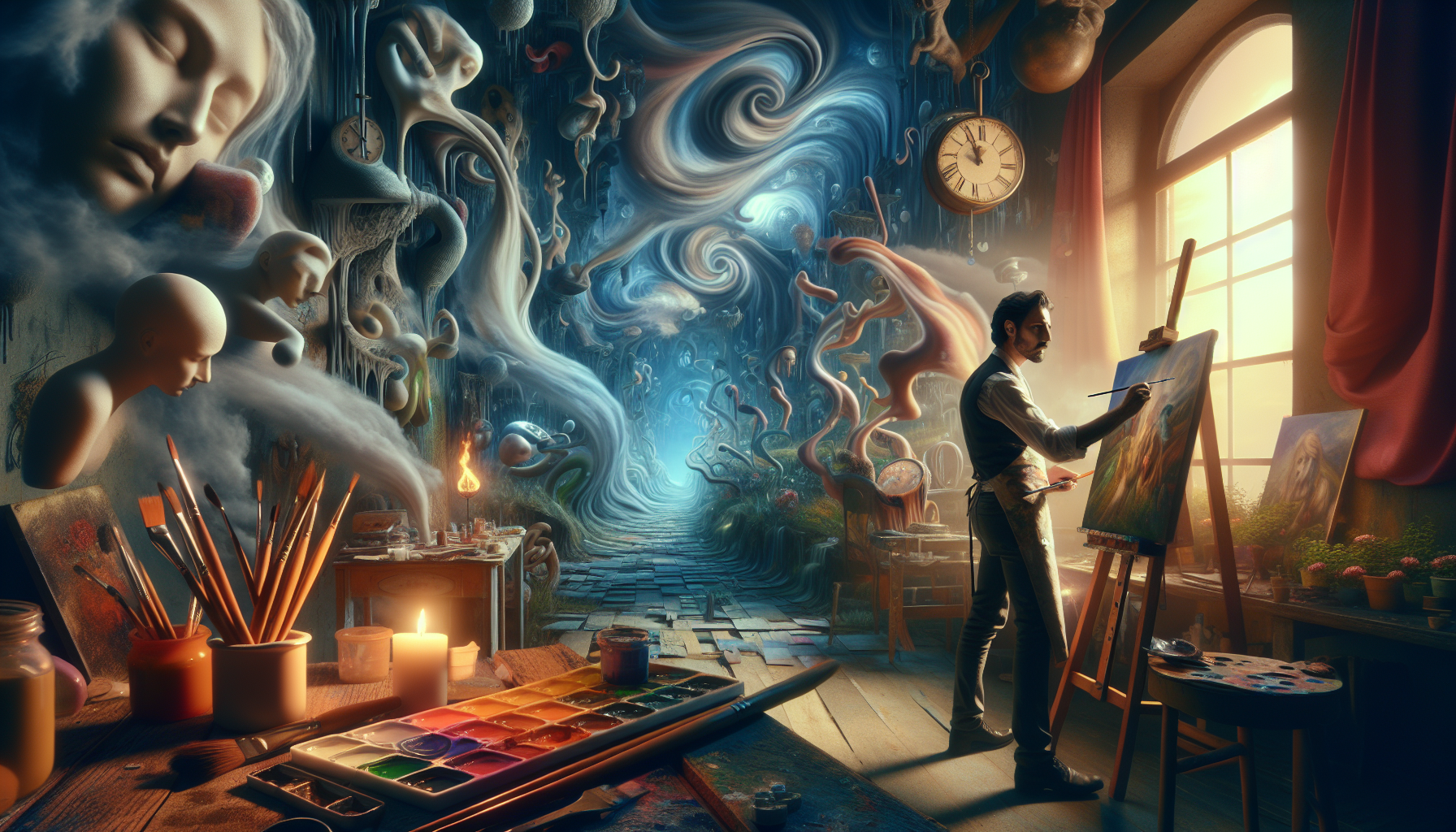
Conclusion
Conclusion: Unveiling the Surreal Worlds of Salvador Dalí
In our exploration of Salvador Dalí’s dream-infused creative process, we have traversed the vivid landscapes of his imagination, delved into the intricacies of his techniques, and uncovered the inspirations that fueled his surreal masterpieces. Dalí, a central figure of the Surrealist movement, not only redefined art but also challenged perceptions of reality itself. His ability to blend dreams with reality has left a lasting legacy that continues to inspire artists and admirers around the globe.
Throughout this article, we have highlighted several key aspects of Dalí’s creative genius. We began by examining his early influences, which ranged from his Catalan heritage to the avant-garde movements of the early 20th century. This eclectic mix of influences provided a fertile ground for Dalí’s unique style to flourish, setting the stage for his later works.
Next, we explored Dalí’s distinctive approach to art-making, particularly his use of the paranoiac-critical method. This innovative technique allowed him to access the subconscious mind, drawing inspiration from the world of dreams and translating it into tangible artistic expression. Through this method, Dalí produced some of his most iconic works, such as “The Persistence of Memory” and “The Elephants,” which continue to captivate audiences with their surreal imagery and profound symbolism.
Furthermore, we discussed Dalí’s collaboration with other prominent figures in the Surrealist movement, such as André Breton and René Magritte, as well as his ventures into other forms of media, including film and literature. These collaborations and experiments not only enriched Dalí’s creative repertoire but also helped to disseminate Surrealism’s ideals to a broader audience.
The importance of Salvador Dalí’s work lies not only in its aesthetic brilliance but also in its ability to provoke thought and question the boundaries of reality. His art invites viewers to step into a world where the impossible becomes possible, challenging us to rethink our perceptions and embrace the unknown. Dalí’s fearless exploration of the subconscious mind serves as a reminder of the limitless potential of human creativity.
As we conclude this journey through Dalí’s dreamlike universe, we are reminded of the enduring impact of his work. His ability to transform dreams into reality and reality into dreams continues to inspire artists, thinkers, and dreamers alike. We encourage you to reflect on the themes discussed in this article and consider how they might apply to your own creative endeavors. Whether you are an artist, a writer, or simply someone who appreciates the beauty of the surreal, Dalí’s legacy offers a wealth of inspiration and insight.
We invite you to engage with this article by sharing your thoughts and reflections in the comments section below. How has Dalí’s work influenced your perspective on art and creativity? What elements of his process resonate with you the most? Additionally, we encourage you to share this article with friends, family, or anyone who might find value in exploring the surreal worlds of Salvador Dalí.
In the words of Dalí himself, “Have no fear of perfection—you’ll never reach it.” Let this be a reminder to embrace the imperfections of our creative journeys and to continually seek out new possibilities, just as Dalí did throughout his illustrious career. 🌟
For further reading on Salvador Dalí and Surrealism, we recommend visiting the following sources:
– MoMA’s Collection of Salvador Dalí – Explore a wide range of Dalí’s works housed in the Museum of Modern Art’s prestigious collection.
– Salvador Dalí Museum – Discover more about Dalí’s life and legacy through the exhibits and resources offered by the Salvador Dalí Museum.
– Surrealism Movement Overview – Gain a deeper understanding of the Surrealist movement and its impact on modern art.
Thank you for joining us on this exploration of Salvador Dalí’s dream-infused creative process. May his visionary art continue to inspire and ignite the flames of creativity within us all.
João is a visual storyteller and dream archivist whose work explores the delicate threshold between memory and imagination. Through layered visuals and symbolic design, he captures the fleeting essence of dreams — those strange, luminous, and sometimes haunting fragments that slip through sleep and echo into waking life.
His creative journey is fueled by a deep fascination with the subconscious and its boundless imagery. From half-remembered landscapes to recurring archetypes and surreal encounters, each piece João creates becomes a portal into an inner archive — where time bends, meanings shift, and personal mythologies emerge.
With a background in handcrafted artistry and visual composition, João weaves intuition and precision together. His work doesn’t just depict dreams; it preserves them, translating ephemeral visions into tangible forms that stir emotion, spark curiosity, and invite reflection. Each creation is both a record and a doorway into the uncharted terrain of the psyche.
Through illustrated dream journals, symbolic explorations, and visual essays, João invites others to engage with the poetic architecture of their own subconscious landscapes. His art acts as a mirror — not only of what we glimpse in sleep, but of what lies quietly within us all.
His work is a tribute to:
-
The fragile beauty of dreams that fade with dawn
-
The symbolic language of the inner mind
-
The unseen worlds we inhabit but seldom name
Whether you are a lucid dreamer, a seeker of hidden meaning, or simply captivated by the mystery of the night’s visions, João welcomes you to step into a space where dreams are not lost — they are kept, one image, one symbol, one story at a time.

